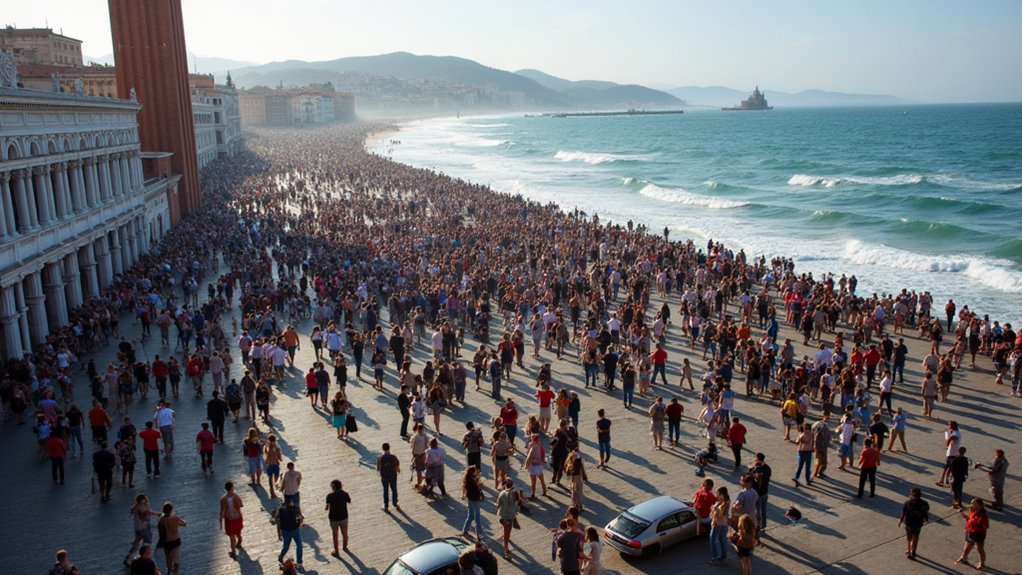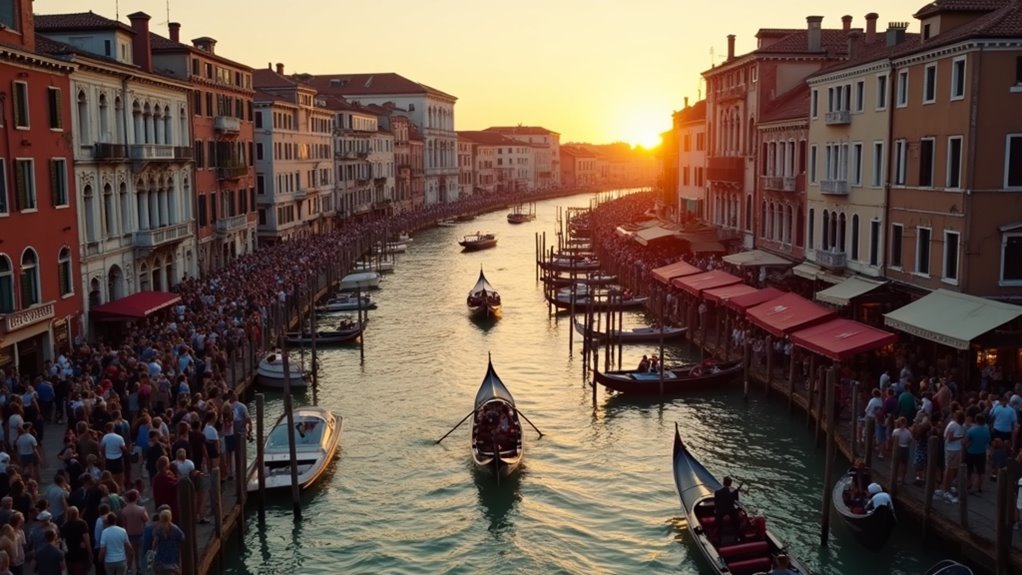Physical Address
304 North Cardinal St.
Dorchester Center, MA 02124
Physical Address
304 North Cardinal St.
Dorchester Center, MA 02124

Notorious tourist traps like Venice and Machu Picchu are crushing authentic experiences while emptying wallets—discover where not to waste your vacation days.
The 5 most overrated travel destinations right now include Venice (drowning in 6 million annual travelers), Koh Samui (suffering from waste management collapse), Kyoto during cherry blossom season (unbearably crowded with tripled prices), Machu Picchu (strained by 1.6 million visitors annually), and Iceland’s Golden Circle (where nature is being trampled). You’ll face overcrowding, inflated prices, and diminished experiences at these hotspots. Discover why these bucket-list destinations might not deliver the authentic experiences you’re seeking.

While Venice has long been celebrated for its unique canal system and historic architecture, the reality of visiting this Italian icon often falls short of expectations. You’ll battle nearly 6 million other travelers in a city that saw record-breaking 13.3 million overnight stays in 2024.
The crush of visitors has transformed this floating city into an overcrowded theme park. You’ll pay premium prices for everything—Venice hotels cost more than Florence or Rome—while competing with day-trippers clogging narrow streets and bridges. The United States has become the leading inbound market for Venice, further intensifying the tourist congestion.
Despite new access fees and ticketing systems aimed at managing crowds, the tourist experience remains frustrating.
The city’s efforts to promote sustainability can’t keep pace with environmental damage and infrastructure strain. What should be a romantic gondola ride often becomes an expensive exercise in dodging boat traffic on polluted canals.
Once a pristine tropical paradise, Koh Samui has transformed into yet another victim of Thailand’s tourism explosion. With a 28% rise in foreign arrivals, you’ll find overcrowded beaches and infrastructure struggling to keep pace.
Paradise lost as Koh Samui drowns in tourism, leaving authentic Thailand gasping beneath crowded shores and concrete.
The island’s authentic charm is rapidly disappearing under commercial development. What you won’t see in brochures:
Your luxury shopping and Instagram-perfect beaches come at a steep environmental cost. The White Lotus effect briefly increased the island’s international profile, further accelerating its commercialization. While tourism creates jobs and economic growth, the island faces an identity crisis.
Without sustainable practices and preservation efforts, this “paradise” may soon exist only in vintage travel guides.

Though Kyoto’s cherry blossom season is undeniably beautiful, the reality rarely matches the serene images you’ve seen on travel websites. You’ll face overwhelming crowds at iconic spots like Philosopher’s Path, where the peaceful hanami experience gives way to shoulder-to-shoulder shuffling.
The bloom period is frustratingly unpredictable and brief—often lasting less than a week—while accommodation prices triple. For 2025, experts already anticipate that blossoms will not reach full bloom as expected. You’ll waste precious time in restaurant queues and overcrowded buses. Even photography becomes a competitive sport.
Consider alternatives like Kanazawa or Sapporo, where similar beauty awaits with fewer travelers. Or visit Hokkaido a month later when northern blooms peak.
If you’re set on Kyoto, avoid weekends and prepare for an experience that’s more about maneuvering crowds than connecting with culture and nature.
As the morning sun illuminates Machu Picchu’s ancient stone terraces, you’ll quickly realize this Incan masterpiece bears the weight of its own popularity. With 1.6 million annual visitors cramming into this delicate site, your dream encounter with ancient history might feel more like navigating a theme park during peak season.
The ancient wonder of Machu Picchu now drowns in tourism, transforming mystical ruins into an archaeological amusement park.
The reality of visiting includes:
You’ll pay premium prices for a hurried experience, where conservation measures—though necessary—restrict your movement and time at this bucket-list wonder. Visiting during high season months like May through August means contending with the largest crowds, making your Incan citadel experience even more chaotic and less authentic.

While Iceland’s Golden Circle dazzles on travel brochures with its erupting geysers, thundering waterfalls, and dramatic landscapes, the reality you’ll encounter tells a different story.
You’ll join nearly 2.3 million travelers cramming into a country with just 383,000 residents. Recent data shows a consistent decline in tourism, with February 2025 employment in the industry down 2% compared to the previous year. At Geysir hot springs, you’ll shoulder through crowds that are literally trampling the environment. The government has implemented a 600 ISK tourism tax and seasonal fees to manage the damage, but overcrowding persists.
Despite economic benefits (tourism contributes 8.5% to Iceland’s GDP), the strain on natural sites is evident. The newly introduced “sustainability balance check” signals official concern about tourism’s impact.
For a more authentic experience, consider private tours or visiting during shoulder seasons when you won’t be competing with six times the country’s population for that “perfect” selfie.
You’ve glimpsed the reality behind the Instagram filters. Like Venice’s foundations slowly sinking beneath tourist feet, many dream destinations now crumble under their own popularity. But travel isn’t dead—it’s evolving. Next time, consider trading Machu Picchu’s crowded paths for Peru’s lesser-known Choquequirao, where fewer than 20 visitors arrive daily. The world’s most meaningful experiences often hide just beyond the guidebook’s final page.